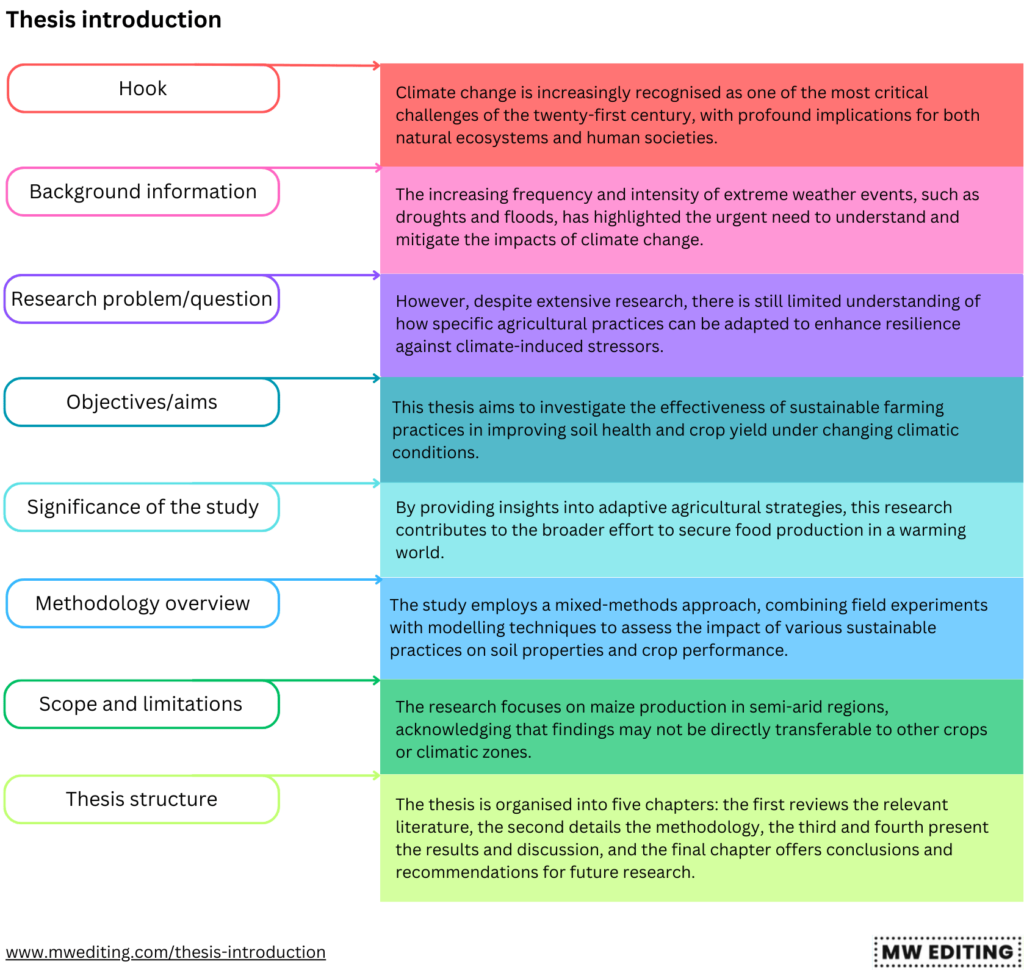A thesis introduction is the opening section of a thesis that provides context for the research, outlines the research problem or question and sets the stage for the entire study. Its purpose is to introduce the topic, establish the significance of the research and guide the reader through the structure and objectives of the thesis.
A thesis introduction is critical because it engages the reader, clearly defines the research problem and provides the necessary context and rationale for the study. It sets expectations for the content and structure of the thesis. Finally, it helps the reader understand the relevance and significance of the research.
What are the key elements of a thesis introduction?
The introduction of a thesis is a crucial section that sets the stage for the entire research. It should be well-structured and clear. The key elements typically include:
- Background information: Provide context to the research by outlining the broader area of study and the specific issues being addressed.
- Research problem or question: Clearly state the problem or question that the research aims to address. This is often articulated as a gap in existing knowledge.
- Objectives and aims: Define the specific aims and objectives of the research. What does the study seek to achieve?
- Significance of the study: Explain why the research is important. This includes discussing the potential contributions to the field and practical implications.
- Scope and limitations: Briefly outline the scope of the research, including any boundaries or limitations.
- Research methodology overview: Provide a brief overview of the methodology used to explain how the research was conducted.
- Structure of the thesis: Summarise the structure of the thesis, outlining what each chapter will cover.
How to structure a thesis introduction?
To structure a thesis introduction effectively, follow this outline:
- Begin with a hook: Start with an engaging statement that introduces the problem and captures the reader’s interest.
- Provide background information: Offer relevant background information that sets the stage for the research, helping the reader understand the context.
- State the research problem or question: Clearly define the specific problem, question or gap in knowledge that the research addresses.
- Outline the objectives or aims: Summarise the main objectives or aims of the research, stating what you intend to achieve.
- Highlight the significance of the study: Explain why the research is important and its potential impact on the field.
- Give an overview of the methodology: Briefly describe the research approach and methods you will use to answer the research question.
- Define the scope and limitations: Mention any boundaries or limitations of the study to clarify the research focus.
- Conclude with the thesis structure: Provide a brief overview of the structure of the thesis, indicating what each chapter will cover.

Sample thesis introduction
1. Hook: Climate change is increasingly recognised as one of the most critical challenges of the twenty-first century, with profound implications for both natural ecosystems and human societies.
2. Background information: The increasing frequency and intensity of extreme weather events, such as droughts and floods, has highlighted the urgent need to understand and mitigate the impacts of climate change.
3. Research problem or question: However, despite extensive research, there is still limited understanding of how specific agricultural practices can be adapted to enhance resilience against climate-induced stressors.
4. Objectives or aims: This thesis aims to investigate the effectiveness of sustainable farming practices in improving soil health and crop yield under changing climatic conditions.
5. Significance of the study: By providing insights into adaptive agricultural strategies, this research contributes to the broader effort to secure food production in a warming world.
6. Overview of the methodology: The study employs a mixed-methods approach, combining field experiments with modelling techniques to assess the impact of various sustainable practices on soil properties and crop performance.
7. Scope and limitations: The research focuses on maize production in semi-arid regions, acknowledging that findings may not be directly transferable to other crops or climatic zones.
8. Thesis structure: The thesis is organised into five chapters: the first reviews the relevant literature, the second details the methodology, the third and fourth present the results and discussion and the final chapter offers conclusions and recommendations for future research.
Tips for writing an effective thesis introduction
Here are some tips for writing an effective thesis introduction:
- Start broad, then narrow down: Begin with a broad context to engage the reader and gradually narrow down to the specific research problem. This approach helps to situate the work within a larger framework.
- Be clear and concise: Avoid jargon and complex language. The introduction should be accessible to readers who may not be experts in the field.
- Highlight the gap in knowledge: Clearly identify the gap in existing research that the thesis addresses. This is crucial for demonstrating the originality and significance of the work.
- Justify the research: Explain why the study is important. Discuss its potential contributions to the field or its practical implications, which add weight to the research.
- Engage the reader early: Use a compelling hook or a striking statistic to grab the reader’s attention from the outset.
- Be specific about the aims: Clearly state the research objectives or questions. This helps to set clear expectations for the reader.
- Provide a roadmap: Briefly outline the structure of the thesis. This helps the reader understand the organisation of the work and what to expect in each chapter.
- Revise and refine: After writing, revise the introduction to ensure clarity and coherence. It often helps to revisit and refine the introduction after completing the rest of the thesis.
- Seek feedback: Before finalising the introduction, get feedback from peers or advisors. They can provide insights into how well the introduction sets up the rest of the thesis.
- Consider the examiner’s perspective: Remember that while you have read and revised the introduction multiple times, the examiner or reviewer will likely read it only once. It needs to be clear, concise and well-structured so that they can grasp the key points easily on the first read.
How can editing services help polish a thesis introduction?
Using editing services for copyediting and proofreading ensures that the thesis introduction is not only error-free but also clear, concise and professionally written. This is crucial as the introduction sets the tone for the entire thesis and is often the first part the examiner reads. A polished introduction can make a strong first impression, helping to convey the significance and quality of the research effectively.
Copyediting
- Clarity and coherence: Copyediting helps to improve the overall clarity and flow of the introduction. An editor will ensure that the ideas are logically organised and each section transitions smoothly to the next. They can help refine the arguments, making sure that the research problem, objectives and significance are clearly articulated.
- Language and style: A copyeditor will also work on the language, ensuring that it is appropriate for an academic audience. They will check for consistency in tone, remove redundancies and enhance sentence structure to make the writing more concise and impactful.
- Technical accuracy: Copyeditors also check for the correct use of terminology and appropriate citation styles. This ensures the introduction meets academic standards.
Proofreading
- Grammar and punctuation: Proofreading focuses on correcting grammatical errors, typos, punctuation mistakes and other minor issues that can detract from the professionalism of the thesis introduction.
- Spelling and consistency: Proofreaders will ensure that spelling is consistent throughout (e.g. UK vs. US English). Moreover, they work to eliminate inconsistencies in the use of names, terms or formatting.
- Final polish: Proofreading provides a final polish to the introduction, ensuring it is error-free and ready for submission. This last step is crucial as even small mistakes can leave a negative impression on the examiner.
Resources for writing a thesis introduction
Here are some helpful resources for writing a thesis introduction:
- How to Write a Better Thesis by David Evans, Paul Gruba and Justin Zobel is a detailed guide on writing a thesis, with specific sections on developing an effective introduction.
- Purdue OWL offers extensive resources on academic writing, including tips on writing thesis statements and introductions.
- The Craft of Research by Wayne C. Booth, Gregory G. Colomb and Joseph M. Williams offers comprehensive guidance on all stages of research writing, including how to craft a strong introduction.
- The Thesis Whisperer blog is dedicated to helping PhD students with various aspects of thesis writing, including writing introductions.
- Writing Your Thesis by Paul Oliver provides practical advice on structuring and writing each section of the thesis, including the introduction.
Key takeaways
In conclusion, crafting a strong thesis introduction is essential for setting the stage for the research. A clear structure, defining the research problem and outlining the objectives will guide the reader effectively. Additionally, using editing services can polish the introduction, ensuring clarity and professionalism. Remember, a well-written introduction not only engages the reader but also establishes the research significance. With careful attention to detail, you can create an introduction that leaves a lasting impression.
If you are an academic author looking to publish your work and need editing or indexing services, contact me. I am an experienced editor, and I offer a free sample edit and an early bird discount.


